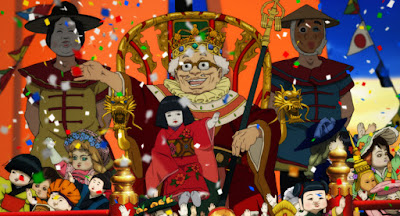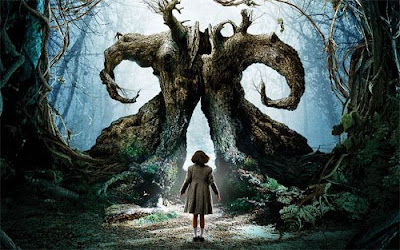
Last night Kristin, Lydia, and I decided to celebrate the season with a night of "ho ho horror." With Silent Night, Deadly Night (1984) and Black Christmas (1974), all we wanted was the classic Christmas horror comedy
Gremlins (1984) to complete the trio. At nearly every video store we received the same dire news: "Gremlins is out," before locating a copy at the Cinemat. Of course, it was a popular movie. What child of the eighties could forget Gizmo's adorable chirping, cruel Mrs. Deagle propelled out of her bedroom window, or the Gremlins' taste for, well, just about anything (as Lydia pointed out, never before had "yum yum" been uttered so menacingly). But watching to movie as an adult, I soon came to realize that Gremlins was a remarkable sign of the times, consciously referencing the early 1980s recession, the booming film industry, the normalization of Sino-American relations and the consequent fear of an invasive, rapidly multiplying hordes of technologically-oriented Other.
The economic plight of the ordinary residents of Kingston Falls, contrasted sharply with Mrs. Deagle's pursuit of money for money's sake ("The bank and I have the same purpose in life - to make money"), centers around scenes of the aptly named "Savings & Loan" bank, in an almost painfully obvious reference to the savings and loan crisis which began with billion-dollar losses from 1980 to 1982. As Mrs. Deagle tramples upon her less-fortunate neighbors, the lovable, middle-class, boy-next-door hottie Billy Peltzer (Zach Galligan - who now has a
blog) is threatened with unemployment. His father, Randall Peltzer, is an inventor who spends much of the movie tinkering in the basement, peddling his wares, and attending an inventors' convention where his "bathroom buddy" is one-upped by a real-life time machine and a humanoid robot. The family simply cannot afford not to work during the holidays.
The economic disparity between Mrs. Deagle and "the bank" and the ordinary residents of Kingston Falls is mise en abyme when Billy returns home to find his mother slaving away in the kitchen while watching It's a Wonderful Life. While Frank Capra's film is such a holiday standby that it does not seem at all out of place in a movie that takes place at Christmas, who can resist comparing Bedford Falls and Kingston Falls? Mr. Potter's disregard for human life and Mrs. Deagle's equally revolting treatment of others? I don't want to force the comparison; what is more striking is that Mrs. Peltzer is watching the television in the kitchen. Television and cinema is so ubiquitous that one might be tempted to argue that the truly pervasive threat in Gremlins is not an army of little green men, but the omnipresence of visual media. From the kitchen screening of It's a Wonderful Life to Billy watching Invasion of the Body Snatchers to the gremlins' Snow White sing-along, the movie is, as Kristin put it, "so meta." Nowhere is the film more meta-cinematic than in the gremlins' appreciation and appropriation of Hollywood. At the movie theater, the gremlins are captivated by Snow White. But their fascination is not that of a foreigner looking in, but of a dyed-in the wool cinephile: they sing along with the seven dwarves, feast on popcorn, and request Milk Duds (does anyone eat these things outside of the theater?). Earlier, at the town bar, one gremlin stands out as he so consciously embodies film noir: brooding in a corner surrounded by smoke and sporting a fedora. In more than once instance, film seems to become reality. The gremlins' transformation is foreshadowed by the hatching pod scene from Invasion of the Body Snatchers. At the theater, when Snow White ends, the shadows of the angry gremlins are projected onto the back of the movie screen before they literally tear through it. During the final confrontation in the toy store, Gizmo hops into a hot pink Barbie car to save Billy and Kate from head gremlin Stripe and cruises through the store as we here Clark Gable's voice entone: "It takes a certain kind of guy. And that guy needs a certain kind of dame" in a reference to Clarence Brown's To Please a Lady (1950), where Gable plays a race car driver. Gizmo, like the noir gremlin at the bar, imagines himself in a fictional role. As perfect consumers of media, could the gremlins be a criticism of the public's thirst for film? At the end of the movie, Mr. Wing notices Gizmo's attention to the television and asks, astonished: "You let him watch television? Aiiiee yah! (Gremlins does not want for caricatures of Asian people)."
Or is the film critical of the public's thirst for movie merchandise, the mass-produced t-shirts, lunchboxes, action figures, stickers, etc. that followed in the wake of Star Wars and E.T.? Could the gremlins' menacing "yum yum" mean to echo our own gluttonous consumerism? In some ways, the gremlins resemble Romero's uber-consumer zombies in Dawn of the Dead (1978), indulging an insatiable appetite and leaving a wake of destruction. A quick glance at the
Wikipedia entry for Gremlins reveals that more than one critic has noted satirical elements in the gremlins' gluttony. Maybe I am giving the film more credit than it deserves, but the constant references to film represent its best, albeit heavy-handed, satire. It is just as easy to watch the gremlins guzzle beer, stuff themselves with candy, and smoke packs of cigarettes and safely judge their adolescent misbehavior as it is to watch Romero's zombies gorge themselves on the living and frown upon mindless consumerism. It is much harder to pass judgment on a medium in which one is directly implicated.
But if Gremlins succeeds in commenting upon America's love-affair with cinema, it uncritically reproduces the most upsetting stereotypes of Asians and ultimately vindicates Mr. Futterman's xenophobia. From the outselt, Mr. Futterman decries the worthlessness of foreign cars ("they always freeze up on you") and seethes at the sight of subtitles ("Goddamn foreign TV"). Gremlins, as legend would have it, are mischievous and technologically-savvy creatures with a penchant for sabotaging aircraft. For Mr. Futterman, they are the hallmark of foreign technology: "You gotta watch out for foreigners.They plant gremlins in their machines. The same gremlins brought down our planes in the big one." The "big one" is WWII and the gremlins in question Axis sympathizers. For Mr. Futterman, the war continues as German and Japanese cars invade the American market. His fears are realized as gremlins toy with his TV antenna, bringing French (who can think of a more un-American culture?!) into his living room, and then take the wheel of a snow plow and run over Mr. and Mrs. Futterman. In 1979 Deng Xiaoping visited Washington D.C. and later that year China and the USA established bilateral relations after years of shaky diplomacy. For xenophobes like Mr. Futterman, this must have amounted to sleeping with the enemy. Gremlins would soon overrun the US. And how. The gremlins adapt perfectly to American culture. Like a modern-day Trojan Horse, Randall Peltzer's gift to his son allows the enemy to attack from within. Falling back on the narrative of consumerism, Randall insisted that he had to have the mogwai, whatever the cost. Mr. Wing's grandson made the deal behind his back because they "need the money." And so a back-alley financial transaction between an American businessman and a Chinese shopkeeper results in the realization of Mr. Futterman's gremlin nightmares.
What puzzled Kristin and me was the appeal of Gremlins today. Perhaps, tied as it is to the recession of the 1980s, viewers in 2008 can project their own economic worries onto the movie. "With mogwai comes much responsibility!" admonishes Mr. Wing at the beginning and end of the film. I cannot help but see in the little green (like the dollar) monsters the horrors of financial deregulation (capitalism run amok). Born of an illicit financial transaction, the gremlin invasion thrives on unscrupulous handling. Of course, much of its appeal may also lie in its kitschiness. Like other eighties blockbusters, Gremlins produced enough box-office revenue and enough merchandise to earn itself a place in the annals of American pop culture.
Despite the dull acting, the bad special effects, and the cheesy synthesizer theme-song, Gremlins is a great movie, at once representative of the 1980s zeitgeist and sufficiently "meta" to entertain cinephiles and armchair film theorists.
 Roger Ebert criticized this film for being "heavy handed and old fashioned." Considering the movie's egregious glorification of a widely unpopular war, its simple vilification of the media for speaking out against the conflict, and its deeply racist representations of the Vietnamese people, history, culture, and political context, I'd say it's a fair critique. I also would place this movie on my list of most hated, but mostly because it's loud and sort of uninteresting. Normally I would try to comment more extensively on the film's plot, characters, etc., but I feel much more compelled to comment that my Christmas break was pretty hectic, that I disappointingly left my knitting needles at home, but that happily my step-mom made corn casserole, so things pretty much evened out. George Takei is in this, and the new Star Trek movie is going to be so unspeakably cool. Also, you wouldn't know it from looking at me, but I have really low blood pressure.
Roger Ebert criticized this film for being "heavy handed and old fashioned." Considering the movie's egregious glorification of a widely unpopular war, its simple vilification of the media for speaking out against the conflict, and its deeply racist representations of the Vietnamese people, history, culture, and political context, I'd say it's a fair critique. I also would place this movie on my list of most hated, but mostly because it's loud and sort of uninteresting. Normally I would try to comment more extensively on the film's plot, characters, etc., but I feel much more compelled to comment that my Christmas break was pretty hectic, that I disappointingly left my knitting needles at home, but that happily my step-mom made corn casserole, so things pretty much evened out. George Takei is in this, and the new Star Trek movie is going to be so unspeakably cool. Also, you wouldn't know it from looking at me, but I have really low blood pressure.
















